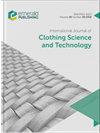基于空间矢量和距离轻松度的个性化服装图案生成
IF 1
4区 工程技术
Q3 MATERIALS SCIENCE, TEXTILES
International Journal of Clothing Science and Technology
Pub Date : 2023-07-10
DOI:10.1108/ijcst-10-2022-0152
引用次数: 0
摘要
目的单纯考虑二维(2D)舒适度,不能充分反映服装位置与人体之间的三维(3D)关系。本文的目的是提出一种利用三维空间向量和相应的距离向量来表征合身服装的方法,并以此来构建相似体型的个性化服装。设计/方法/方法首先,使用三维扫描仪获取人体模型和合身的服装数据,并提取上半身17层横截面。然后,利用原始点在每个截面上得到37个空间矢量和对应的空间角度。其次,根据服装向量和身体向量的不同,构建了人体模型与服装之间的详细距离模型;第三,建立了距离易度数学模型,并应用于相似形状物体的距离易度计算。此外,构建合身的服装,并通过几何图案改变方法改变服装图案。结果表明,三维空间向量能较好地解释人体皮肤与上半身服装表面的关系。用数学表达式对距离进行了建模,并成功地用于制作适合相似体型的新服装。提出了一种基于距离轻松度和三维空间矢量的服装构造方法,可以有效、准确地为相似体型的服装制作合身的服装。适用于服装的个性化设计和生产工艺。本文章由计算机程序翻译,如有差异,请以英文原文为准。
Personalized garment pattern generation based on space vector and distance ease
PurposeConsidering only two-dimensional (2D) ease allowance cannot fully reflect the three-dimensional (3D) relationship between the position of clothing and the human body. The purpose of this paper is to propose a method with a 3D space vector and corresponding distance ease to characterize fitting garments and then used to construct personalized clothing for similar shape body.Design/methodology/approachFirstly, a 3D scanner was used to obtain mannequin and fitted garment data, and 17 layers of cross-sections of the upper body were extracted. Then, 37 space vectors and corresponding space angles on each cross-section were obtained with the original point. Secondly, the detailed distance ease between the mannequin and garment was constructed due to the difference between garment vectors and body vectors. Thirdly, the distance ease mathematical models were achieved and used to calculate distance ease on a similar shape body. Additionally, the fit garment is constructed, and the garment pattern is altered by the geometric pattern alteration method.FindingsThe results show that 3D space vectors can explain the relationship between body skin and garment surface of the upper body properly. The distance ease is modeled by mathematic expressions and successfully used to make a new garment to fit a similar shape body.Originality/valueThe proposed method of constructing garments based on distance ease and 3D space vectors can create a fitted garment for a similar shape body effectively and accurately. It is useful for the personalized garment design and suitable for the manufacturing process.
求助全文
通过发布文献求助,成功后即可免费获取论文全文。
去求助
来源期刊
CiteScore
2.40
自引率
8.30%
发文量
51
审稿时长
10 months
期刊介绍:
Addresses all aspects of the science and technology of clothing-objective measurement techniques, control of fibre and fabric, CAD systems, product testing, sewing, weaving and knitting, inspection systems, drape and finishing, etc. Academic and industrial research findings are published after a stringent review has taken place.

 求助内容:
求助内容: 应助结果提醒方式:
应助结果提醒方式:


